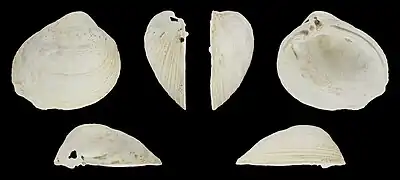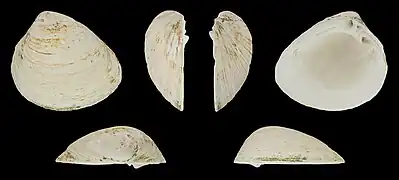| Rangia cuneata | |
|---|---|
 | |
| Scientific classification | |
| Domain: | Eukaryota |
| Kingdom: | Animalia |
| Phylum: | Mollusca |
| Class: | Bivalvia |
| Order: | Venerida |
| Family: | Mactridae |
| Genus: | Rangia |
| Species: | R. cuneata |
| Binomial name | |
| Rangia cuneata (G. B. Sowerby I, 1832) | |
| Synonyms[1] | |
| |
Rangia cuneata or Atlantic rangia, also known as wedge clam, gulf wedge clam, common rangia, and cocktail clam, is a mollusc native to the Gulf of Mexico. It is an oval clam with a body length of up to 5cm, living from the intertidal zone to depths of 124 meters.[2] It is edible and is harvested for food in Mexico, and has been so since pre-Hispanic times.[3]
 Right valve
Right valve Left valve
Left valve
Invasive species
Atlantic rangia have been introduced to the US North Atlantic coast, Belgium (Antwerp) and the Baltic sea.[4]
References
- ↑ Bieler R, Bouchet P, Gofas S, Marshall B, Rosenberg G, La Perna R, Neubauer TA, Sartori AF, Schneider S, Vos C, ter Poorten JJ, Taylor J, Dijkstra H, Finn J, Bank R, Neubert E, Moretzsohn F, Faber M, Houart R, Picton B, Garcia-Alvarez O, eds. (2021). "Rangia cuneata (G. B. Sowerby I, 1832)". MolluscaBase. World Register of Marine Species. Retrieved 16 August 2021.
- ↑ "Rangia cuneata". SeaLifeBase. Retrieved 2020-01-24.
- ↑ Wakida-Kusunoki, Armando T. & Clyde L. MacKenzie, Jr (2004). "Rangia and marsh clams, Rangia cuneata, R. flexuosa, and Polymesoda caroliniana, in Eastern México: Distribution, biology and ecology, and historical fisheries" (PDF). Marine Fisheries Review. 66 (3): 13–20.
- ↑ "Rangia cuneata". National Exotic Marine and Estuarine Species Information System. Retrieved 2020-01-24.
This article is issued from Wikipedia. The text is licensed under Creative Commons - Attribution - Sharealike. Additional terms may apply for the media files.